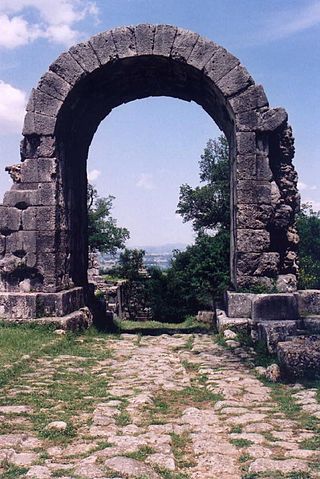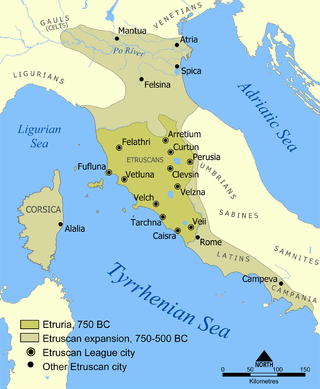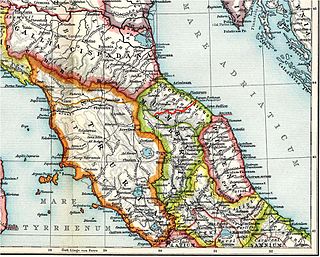
The First, Second, and Third Samnite Wars were fought between the Roman Republic and the Samnites, who lived on a stretch of the Apennine Mountains south of Rome and north of the Lucanian tribe.

The Via Flaminia was an ancient Roman road leading from Rome over the Apennine Mountains to Ariminum (Rimini) on the coast of the Adriatic Sea, and due to the ruggedness of the mountains was the major option the Romans had for travel between Etruria, Latium, Campania, and the Po Valley. The section running through northern Rome is where Constantine the Great, allegedly, had his famous vision of the Chi Rho, leading to his conversion to Christianity and the Christianization of the Roman Empire.

Romagna is an Italian historical region that approximately corresponds to the south-eastern portion of present-day Emilia-Romagna in northern Italy.
The Allobroges were a Gallic people dwelling in a large territory between the Rhône river and the Alps during the Iron Age and the Roman period.

Gaius Flaminius was a leading Roman politician in the third century BC. Flaminius served as consul twice, in 223 and 217. He is notable for the Lex Flaminia, a land reform passed in 232, the construction of the Circus Flaminius in 221, the construction of the Via Flaminia, and his death at the hands of Hannibal's army at the Battle of Lake Trasimene in 217, during the Second Punic War. Flaminius is celebrated by ancient sources as being a skilled orator and a man possessed of great piety, strength, and determination. He is, however, simultaneously criticised by ancient writers such as Cicero and Livy for his popular policies and disregard of Roman traditions, particularly during the terms of his tribunate and second consulship.

The Battle of the Allia was a battle fought c. 387 BC between the Senones – a Gallic tribe led by Brennus, who had invaded Northern Italy – and the Roman Republic.

The Senones or Senonii were an ancient Gallic tribe dwelling in the Seine basin, around present-day Sens, during the Iron Age and the Roman period.

Regio VI Umbria is the name for one of the 11 administrative regions into which the emperor Augustus divided Italy. The main source for the regions is the Historia Naturalis of Pliny the Elder, who informs his readers he is basing the geography of Italy on the descriptio Italiae, "division of Italy", made by Augustus. The Regio Sexta is called Umbria complexa agrumque Gallicam citra Ariminium.

Italia, also referred to as Roman Italy, was the homeland of the ancient Romans. According to Roman mythology, Italy was the ancestral home promised by Jupiter to Aeneas of Troy and his descendants, Romulus and Remus, who were the founders of Rome. Aside from the legendary accounts, Rome was an Italic city-state that changed its form of government from Kingdom to Republic and then grew within the context of a peninsula dominated by the Gauls, Ligures, Veneti, Camunni and Histri in the North, the Etruscans, Latins, Falisci, Picentes and Umbri tribes in the Centre, and the Iapygian tribes, the Oscan tribes and Greek colonies in the South.

Picenum was a region of ancient Italy. The name was assigned by the Romans, who conquered and incorporated it into the Roman Republic. Picenum became Regio V in the Augustan territorial organisation of Roman Italy. It is now in Marche and the northern part of Abruzzo.
The Battle of Arretium, which was probably fought in 284 BC, is a poorly documented event in the history of the Roman Republic because it occurred in a period for which some of the books of the History of Rome by Livy, the most thorough ancient historian for early Rome, have been lost. The battle is only explicitly referred to in a text by Polybius, the ancient Greek historian, which does not give much detail and puts it in the context of other events. A text by Appian talks about these events, but does not make any explicit reference to the Battle of Arretium. It was fought between the Romans and the Gauls of northern Italy, who may have been from the Senone tribe.

The second Battle of Lake Vadimo was fought in 283 BC between Rome and the combined forces of the Etruscans and the Gallic tribes of the Boii and the Senones. The Roman army was led by consul Publius Cornelius Dolabella. The result of the battle was a Roman victory.

The Insubres or Insubri were an ancient Celtic population settled in Insubria, in what is now the Italian region of Lombardy. They were the founders of Mediolanum (Milan). Though completely Gaulish at the time of Roman conquest, they were the result of the fusion of pre-existing Ligurian and Celtic population with Gaulish tribes.

Brennus or Brennos was a chieftain of the Senones. He defeated the Romans at the Battle of the Allia. Later that year, he led an army of Cisalpine Gauls in their attack on Rome and captured most of the city, holding it for several months. Brennus's sack of Rome was the only time in 800 years the city was occupied by a non-Roman army before the fall of the city to the Visigoths in 410 AD.
Britomaris was a war chief of the Senone tribe of the Gauls of northern Italy. He is briefly mentioned in a text by Appian, who said that he killed some Roman ambassadors who were sent to remonstrate about him providing mercenaries for forces which fought the Romans despite having signed a treaty with Rome. Britomaris killed the ambassadors because he was angry about his father having been killed while fighting on the side of the Etruscans "in this very war." Publius Cornelius Dolabella then devastated the ager Gallicus, killed all the men, enslaved the women and children and made the place uninhabitable. Britomaris was taken prisoner for torture.
Publius Cornelius Dolabella was a consul of the Roman Republic in 283 BC. He is best noted for having defeated a combined force of the Etruscans, and the Boii and the Senones, two of the Gallic tribes of northern Italy, at the Battle of Lake Vadimon of 283 BC. Appian named him the leader of the expedition which devastated the Ager Gallicus and expelled the Senones from their land. This episode was also recorded by Polybius. In Polybius' text this happened before the battle of Lake Vadimon. In Appian's text it is unclear and might have happened afterwards.

The Picentes or Piceni or Picentini were an ancient Italic people who lived from the 9th to the 3rd century BC in the area between the Foglia and Aterno rivers, bordered to the west by the Apennines and to the east by the Adriatic coast. Their territory, known as Picenum, therefore included all of today's Marche and the northern part of Abruzzo.

Roman Republican governors of Gaul were assigned to the province of Cisalpine Gaul or to Transalpine Gaul, the Mediterranean region of present-day France also called the Narbonensis, though the latter term is sometimes reserved for a more strictly defined area administered from Narbonne. Latin Gallia can also refer in this period to greater Gaul independent of Roman control, covering the remainder of France, Belgium, and parts of the Netherlands and Switzerland, often distinguished as Gallia Comata and including regions also known as Celtica, Aquitania, Belgica, and Armorica (Brittany). To the Romans, Gallia was a vast and vague geographical entity distinguished by predominately Celtic inhabitants, with "Celticity" a matter of culture as much as speaking gallice.

Over the course of nearly four centuries, the Roman Republic fought a series of wars against various Celtic tribes, whom they collectively described as Galli, or Gauls. Among the principal Gallic peoples described as antagonists by Greek and Roman writers were the Senones, Insubres, Boii, and Gaesatae.

The Battle of Silva Litana was an ambush that took place in a forest 75 miles northwest of the Roman city of Ariminum during the Second Punic War in 216 BC. The Gallic Boii surprised and destroyed a Roman army of 25,000 men under the consul-elect Lucius Postumius Albinus and destroyed the Roman army, with only ten men surviving the ambush, a few prisoners were taken by the Gauls and Postumius was killed, his corpse was decapitated and his skull was covered with gold and used as a ceremonial cup by the Boii. News of this military disaster, reaching Rome probably after the election of consuls for 215 BC in spring 215 BC or after the defeat at Cannae in the fall of 216 BC, triggered a renewed panic in Rome and forced the Romans to postpone military operations against the Gauls until the conclusion of the Second Punic War. Rome decided to focus on defeating Hannibal and sent only two legions to guard against any possible Gallic attack. However, the Boii and Insubres did not attack the Romans to exploit their victory. Cisalpine Gaul remained in relative peace until 207 BC, when Hasdrubal Barca arrived there with his army from Spain.













